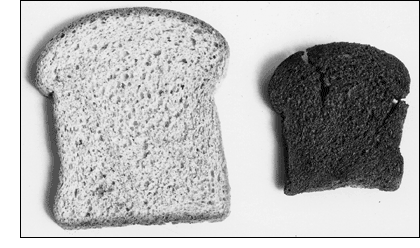
A Decade of Burnt Food (First of three parts)
Our understanding of burnt food has increased tremendously in the past decade. Much of this progress is due to research conducted at the Museum of Burnt Food.
The exhibit wings of the Museum house more than 49,000 scorched, singed, seared, and charred items of staggering diversity, ranging from carbonized elephants, venison, pork, fish and poultry to the celebrated thrice-baked potatoes (see Figure 1).
|
|
|
| Figure 1. Right: a specimen of burnt toast, circa 1980. Left: an artist's reconstruction of what the toast may have looked like | |
The Hall of Burnt Toast alone contains more than 2000 specimens. The Rice and Wheat Gallery also boasts an impressive number of items, many of which are as yet uncatalogued. One wing of the Museum is devoted to burnt legumes. A newly renovated Hall of Charred Comdiments is scheduled to open next May.
The research facilities occupy their own buildings, and are not normally open to public viewing.
The Museum's research staff has published more than ninety books on various aspects of burnt food, and is credited with authorship of more than 850 papers that have appeared in research journals since 1982. Several books for non-specialists, including "The Joy of Burnt Food," "The Carbon Diet" and "Beyond Baking," have aroused the public's interest in post-nutrition science.
The Museum was founded by Deborah Henson-Conant, a science historian who never lost her childhood fascination with organic chemistry. A 1981 accident involving apple cider (see Figure 2) inflamed in her a passionate curiosity about burnt food.
The Museum recently relocate to Arlington, Massachusetts. It is visited annually by more than 25,000 people. The research staff includes 45 post-nutrition food scholars and an extensive support staff. The exhibit wings and restaurant pavilion employ 27 full-time educators and food service workers.
Parts 2 and 3 of this article will present additional photographs of burnt food.
© Copyright 2003 Annals of Improbable Research (AIR)
This is a HotAIR feature. For a complete list of features,
see What's New.
